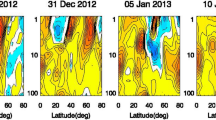Abstract
By comparing the results obtained from two sets of simulations with the ECHAM3 and the ECHAM4 atmospheric general circulation models with results derived from the ECMWF re-analyses, we not only investigate the models’ capability to reproduce aspects of the intraseasonal variability in the extratropics realistically, but also evaluate the impact of the changes between the two different versions of the ECHAM model. Moreover, we assess the impact of the marked variations of sea surface temperatures in the tropical Pacific associated with the El Niño/Southern Oscillation (ENSO) phenomenon on the characteristics of the intraseasonal variability in the midlatitudes. Both models realistically reproduce many aspects of the intraseasonal variability in the extratropics, i.e. the partition of the variability into the contributions of the transient cell and of the stationary and transient eddies and its seasonal variation, and also the spectral distribution of the contribution of the transient waves to the intraseasonal variability. The most severe deficiency of the models is a considerable underestimation of the contributions of the transient waves to the intraseasonal variability, mainly in the low-frequency part of the spectrum. In the recent version of the ECHAM model (ECHAM4) some of the model’s shortcomings in simulating the intraseasonal variability realistically, in particular those in the Southern Hemisphere, are noticeably reduced compared to the previous version (ECHAM3). Yet some aspects are more realistically captured by ECHAM3. Both the ECMWF re-analyses and the two sets of simulations with the ECHAM models reveal a distinct impact of the ENSO phenomenon on the characteristics of the intraseasonal variability within the extratropics in boreal winter. In the Northern Hemisphere the most prominent effect is that the activity of the stationary waves is enhanced during El Niño events at the expense of the transient waves. In the Southern Hemisphere, on the other hand, all the different contributions to the variance on intraseasonal time scales (transient cell, transient and stationary eddies) are stronger during El Niño than during La Niña events. Concerning the transient waves, this mainly reflects changes in the low-frequency part of the spectrum associated with the activity of ultra-long planetary waves.
Similar content being viewed by others
Author information
Authors and Affiliations
Additional information
Received: 25 August 1997 / Accepted: 2 December 1998
Rights and permissions
About this article
Cite this article
May, W. Space-time spectra of the atmospheric intraseasonal variability in the extratropics and their dependency on the El Niño/Southern Oscillation phenomenon: model versus observation. Climate Dynamics 15, 369–387 (1999). https://doi.org/10.1007/s003820050288
Issue Date:
DOI: https://doi.org/10.1007/s003820050288




